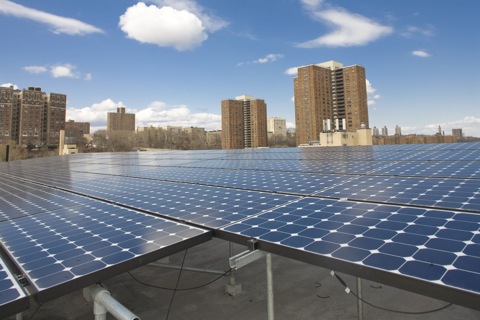Key words :
future energies,
economics
,charles werhane
,doris woo
,enterprise community investment
,environment politics
,nrdc
,shaun donovan
,energy
Green housing for the poor
22 Oct, 2009 02:00 pm
Lots has been written and said about green skyscrapers (like Bank of America?s $1 billion tower in Manhattan) and green campus buildings and even, strange as it sounds, green mansions (like the Atlanta home of Laura Turner Seydel). But what about green...
 |
| Solar roof at Dinkins Gardens, Harlem |
Today, at an event held at the Newseum in Washington, D.C., Enterprise said it had studied the nexus of affordable housing and the environment and found that, in fact, building green affordable homes makes business sense. The payback, executives said, comes in the form of lower utility costs, health benefits and even savings on transportation (if homes are clustered around public transport.) As a result, Enterprise said it would commit $4 billion over the next five years to affordable, environmentally-friendly developments, aiming to build or retrofit 75,000 homes. Its “Green Communities” initiative has been developed in partnership with Natural Resources Defense Council (NRDC).
“By 2013, we want everything Enterprise touches to be green,” said Charles Werhane, the CEO of Enterprise Community Investment. The company called on government and business to make all affordable housing, new and existing, green by 202o.
Doris W. Koo, president and CEO of Enterprise Community Partners, explained that the company has “greened” about 16,000 units of new and existing housing in the last five years to see how the economics work. “We started the journey on a hunch,” she said. “ To get to scale, we had to first collect substantive data and quantifiable results.” Enterprise has developed a set of green criteria which have been adopted by several cities and states and, in part, by the Department of Housing and Urban Development.
Shaun Donovan, the well-regarded HUD Secretary, praised the effort, saying: “You are showing us how you can take to real scale the early work that you have done, and showing us what affordable housing and community development looks like in the 21st century.” He, along with others, noted that 40% of the U.S.’s greenhouse gas emissions come from buildings, so it’s vital that we learn how to make them more efficient.
Unfortunately, Enterprise’s Washington event was long on self-congratulatory rhetoric and short on specifics, so I can’t tell you where and how the $4 billion commitment will be spent. And the business of building affordable housing is so arcane—driven, as it is, by tax credits and subsidies—that it’s hard to know who will pay for the greening of affordable housing and whether today’s call to action will be heeded.
A 120-page report with the sleep-inducing title of “Incremental Costs, Measurable Savings” published by Enterprise and released today provides more detail:
From a strictly financial standpoint, the projected “lifetime” utility cost savings—averaging $4,851 per dwelling unit discounted to today’s dollars—are sufficient to repay the average $4,524 per-unit cost of complying with the Enterprise Green Communities Criteria.
In summary, estimated lifetime savings exceed the initial costs of incorporating the Enterprise Green Communities Criteria into affordable housing. The Criteria offer health, economic and environmental benefits by addressing integrated design, location, site improvements, water conservation, energy efficiency, materials that benefit the environment, healthy living environments, and operations and maintenance of affordable housing.
Most of the savings came from reduced utility bills for water and energy. Health benefits could be significant as well. Enterprise built 60 “breathe easy” homes in the Seattle area aimed at families in which children have asthma, spending an additional $6,000 per unit to reduce moisture and toxins and increase air flow. “The results were absolutely stunning,” Woo said. Children reported a 60% increase in symptom-free days and a 67% reduction in emergency room visits, she said.
If Enterprise’s analysis is right, government and private funders of affordable housing ought to insist on green, efficient performance in the future. Homes that waste energy and water only add to the financial burdens of those who can least afford them. Among those endorsing that idea were the Home Depot and Kresge Foundations, which make donations to Enterprise. Below are images of Enterprise-funded affordable homes.
Originally published at MarcGunther.com
-
12/12/12
“Peak Oil” is Nonsense… Because There’s Enough Gas to Last 250 Years.
-
05/09/12
Threat of Population Surge to "10 Billion" Espoused in London Theatre.
-
05/09/12
Current Commentary: Energy from Nuclear Fusion – Realities, Prospects and Fantasies?
-
04/05/12
The Oil Industry's Deceitful Promise of American Energy Independence
-
14/02/12
Shaky Foundations for Offshore Wind Farms







http://www.selfdestructivebastards.com/2009/11/real-green-houses.html